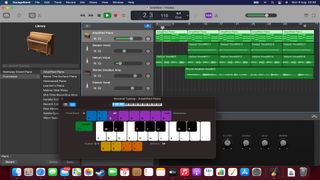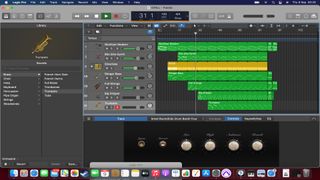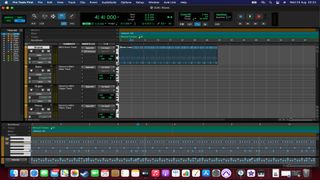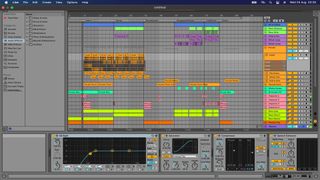Best music production apps for Macs in 2022
Create those beats with style

Being great at guitar or an improvisation king on the piano is only one facet of making good music. In the modern age, being technically great isn’t required if you’re creative enough. How you put together your music is just as important as being able to make it in the first place.
The DAW, or digital audio workstation, is what you need to look at if you’re interested in production. This will allow you to record yourself, and it will actively change the way you make music. Learning to compensate for parameters or workaround systems will shape the way you go about putting everything together.
For this reason, picking the right DAW is important and you're often better off exploring around a little bit before you settle on what works for you. Unfortunately, with the time and money required to do so, this can be a bit of a challenge.
With your MacBook in hand, we will be recommending our picks of the best free music production software suites.

1. GarageBand
Reasons to buy
Reasons to avoid
If you’ve booted up a Mac before, you will be familiar with this software package from Apple. Coming pre-installed on Apple devices, this is a usable and intuitive application with lots of useful built-in features.
You only need to plug in your midi, guitar, or keyboard to create music instantly. With the quick help function, it explains everything you can see in easy-to-grasp concepts, making it a great app for those just starting out.
It has some great functions like a smart drummer, which means you don’t need to create a drum track to have a nice beat in the background. It also has some nice packs to try for midi, like great piano sounds, some orchestral sounds, and some good effects for the guitar.
If you’ve never bothered with music production before, try this before you try anything else on this list. From here, you can read the list and pick your favorite app based on what you like.

2. Logic Pro
Reasons to buy
Reasons to avoid
As the software is still making changes and adapting to the latest M1 chips, there are issues using unofficial software sometimes and it can get a little complicated to start. If you have the time to dedicate, this is one of the very best pieces of software you can find.
If you like GarageBand but just want more out of it, Logic Pro is where you should go from here. This is a great piece of software, offering more sounds to choose from, more robust features to customize your songs, and just general better usability.
It's correct to assume that GarageBand is essentially a 'lite' alternative to Logic – a solid usable app that has some noticeable drawbacks. Logic gets rid of these and adds even more functions. It has better live looping and more intricate tempo options.
It also has plenty of extra software and built-in sounds to get full and vibrant music out of your projects. Alongside this, there are much better mixing options that can give you extra options for the bass and equalizers, depending on the types of genre you're focusing on, making it great for those looking to finish a full song, ready to go on an album.
It also has great intuitive methods to export your songs onto iOS or iPadOS if you want to take your projects on the go.

3. Pro Tools
Reasons to buy
Reasons to avoid
Pro Tools is the industry standard when it comes to DAWs and there’s a reason for that. It’s powerful, can handle pretty much anything you throw at it and it is great when using across platforms.
If you want to work on a project with someone else or want to learn the software most professionals are used to, this is a valuable application to learn.
That said, it can be a little hard to get used to. It isn’t quite as intuitive as our previous choices and is loaded with options. Pro tools can be used for free with a trial but will cost you more in the long run with monthly/yearly plans.
Pro Tools' cloud features and great plug-in options make the app a fantastic choice, albeit with a steep learning curve and high price. If you’re looking for something complex that is used by industry professionals, this is the app for you.

4. Ableton Live 11
Reasons to buy
Reasons to avoid
Ableton Live is an excellent app for those who like to improvise. All of its software is based around live sessions, giving your music a raw feel. It’s much better at allowing you to just sort of jam, then fine-tune every aspect of your music.
Out of all the paid apps here, this one could be bought alongside another (if you have the cash and patience) as its unique selling point makes it worth trying regardless. There are three central price tiers for the app; the top one is rather expensive, but the cheaper options are a good start.
Its focus on live play means there are some pretty solid built-in loops and instruments to use, perfect for setting up a track. Where other apps often get lost in the weeds, figuratively speaking, Ableton Live is great for just letting you in there to mess around.
If you like the idea of composing on the fly, you should try this one out.

5. FL Studio
Reasons to buy
Reasons to avoid
Originally known as FruityLoops, FL Studio has come an incredibly long way since its release two decades ago. Its functionality is entirely based around loops, making it great for genres like EDM or trap.
You essentially build loops in a separate track and place them into your main track. This means coming up with ideas that are only used once or ever-changing songs can become a tedious process.
While it has the ability to play and record, fixing that afterward becomes a little bit of a hassle due to its architecture. The loop-focused build of this software often makes you write a little outside what you’re used to, which is great but also gets in the way of your own ideas.
This also makes learning it a little confusing but, if you can get over that learning curve, it’s a solid and versatile DAW that may make you think outside the box.
Get daily insight, inspiration and deals in your inbox
Get the hottest deals available in your inbox plus news, reviews, opinion, analysis and more from the TechRadar team.

James (he/they) is a freelance games journalist with over 500 pieces published at outlets including GamesRadar, NME, Prima Games, VG247, and God is a Geek.
